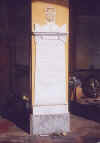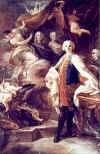|
CENTRO STUDI FARINELLI |
Luigi Verdi, La
tomba del Farinelli alla Certosa
di Bologna, in “Il Carrobbio”, XXIV, 1998, pp.173-184.
Musica a Bologna, Musicisti a Bologna
 In
the Will of famous castrato singer
Carlo Broschi called Farinelli’s, which is dated 8 October 1778 and kept at
the State Archives in Bologna, it is possible to read:
In
the Will of famous castrato singer
Carlo Broschi called Farinelli’s, which is dated 8 October 1778 and kept at
the State Archives in Bologna, it is possible to read:
“When I am dead, I want my miserable corpse to be wrapped in
the mantle of the Order of Calatrava, according to what is prescribed
by the Constitutions of said Royal
Military Order and to be buried without pomp with the accompaniment of poor
in the number of fifty, each one holding a wax candle in the hand, and
each of said poor to be given a coin everyone after having accompanied my corpse
to the church of the Cappuccini Fathers, where I fix my burial place (…)“
Therefore Farinelli had arranged for his corpse to be buried
at the Chiesa dei Cappuccini upon Monte Calvario (where today Villa
Revedin is situated), at San Michele in Bosco. He purchased his sepulchre on 23
August 1779 as from a document kept at the State Archives (Religious
corporations, State Fund 3/6745). Farinelli’s funerals were celebrated in the
church of San Martino in Bertalia, the parish in the territory of which , in via
delle Lame 228 (today via Zanardi 30), the Villa where Farinelli lived from 1761
to his death was situated.
Farinelli’s death certificate, kept at the Archives of the parish Church of
San Martino in Bertalia, bears the date of 17 September 1782 and goes as follows:
"Die 17 Septembris 1782 “Carolus olim Broschi equis Calatravae ex hac
Parecia S.Martini Bertaliae et Roveretoli uniti aetatis suae annorum septuaginta
nonam anima Deo reddidit in Comunione S. M. Ecclesiae in domo propria cuius
corpus die sequenti translatum, et sepultus fuit in ecclesia P.P. Capucinorum
Bononiae mihi P. Dominico Balestri confessus fuit die 12 septembris et die 15
eiusdem sacro viatico, ac oleo sacro munitus fuit. Ita est. Dominicus Benassi
S.T.D. et Parochus”.
On
the arrival of the French (1796), the Monte Calvario cloister of the Cappuccini
was closed. Afterwards, the Church of S.Croce was demolished while the cloister
was changed into a patrician villa in a neo-classical style by
the Bentivoglio Counts. From 1857 it was a property of
the Revedin Counts; today it is the seat of the Archiepiscopal Seminar.
With the demolition of the Cappuccini Church of S. Croce, the traces of
Farinelli’s tomb are lost, infact in 1891, about one century after, the
eminent and reliable scholar Corrado Ricci would write:
“Upon
a charming and gentle bend, on the left of S.Michele in Bosco Hill, among thick
woods, there used to stand the church were Farinelli was buried. The friars
there enjoyed the balmy air and the
bright view of the Po valley and of
Bologna there below! But no
happiness lasts forever on Earth! Like a hasty hurricane, the French revolution
swept away even those peaceful and happy inhabitants. Their monastery was
changed into a villa, what is today Revedins’ Villa, and nothing more is known
about Farinelli’s sepulchre!!"
Click here to request the complete text (Italian version only)
Look for Farinelli's Grave in Findagrave
